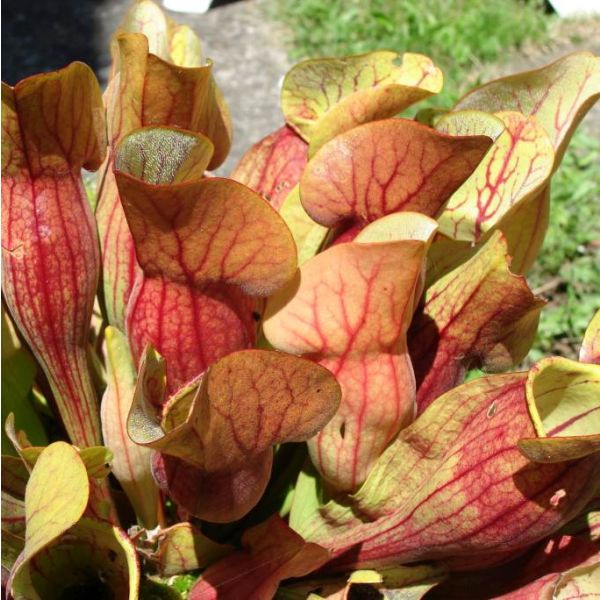Sarracenia Purpurea Seeds (Purple Pitcher Plant Seeds)
Sarracenia Purpurea Seeds (Purple Pitcher Plant Seeds)
The hood on the pitcher is positioned vertically; the pitcher usually being full or partly full of rainwater.

Delivery
All orders shipped with UPS Express.
Always free shipping for orders over US $250.
All orders are shipped with a UPS tracking number.
Returns
Items returned within 14 days of their original shipment date in same as new condition will be eligible for a full refund or store credit.
Refunds will be charged back to the original form of payment used for purchase.
Customer is responsible for shipping charges when making returns and shipping/handling fees of original purchase is non-refundable.
All sale items are final purchases.
Help
Give us a shout if you have any other questions and/or concerns.
Email: contact@domain.com
Phone: +1 (23) 456 789
Availability: Out of stock
SKU
Sarracenia Purpurea
Sarracenia purpurea is an evergreen widespread in Eastern USA and Canada, extending from New Jersey to the Northwest Territory of Canada. The pitchers grow to only 6 inches, 15 cm in height.
The flowers appear in Spring; they are purple or greenish purple and are up to 2.5 inches, 6.5 cm across. The pitchers are produced each year from stems arising from the rhizomes and remain evergreen. Clip off old leaves to make way for flower buds and new leaf growth. The pitchers are slender at the basal rosette, rapidly becoming swollen higher up. Their outer surface is slippery smooth. They are usually yellow-green to dark purple and most commonly a middle variation with strong red venation. In full sunlight the pitchers are dark red coloured. The hood on the pitcher is positioned vertically; the pitcher usually being full or partly full of rainwater.
Insects are attracted to the colorful leaf rosettes that resemble flowers; the red lip of the pitcher is particularly attractive. Red veins that lead downward are baited with nectar. The animal falls into the pitcher, which contains rain, dew, and a digestive enzyme that soon dissolves the victim. Once inside, they will find that retreat is impossible, due to short stiff hairs pointing downward. The inside of the pitchers are also very slippery, even to insects with the best traction. It is necessary for rain to be present inside the pitcher to speed up the process of digestion. With this in mind, plants grown indoors should have a little rainwater poured into the pitchers as they open.
They can grow well in pure sphagnum moss, live, long fibered or shredded, as well as the standard peat moss/sand which can be anything from 30% to 100% peat moss. There's no need to fertilize, as the plant relies on insects for food. The humidity should be between 60-80%.
Requires consistently moist soil; do not let dry out between waterings. Water must be distilled or rain water because they do not tolerate city or hard water. It is a good idea to place a pie pan or large saucer, with about an inch of water in it, under the pot. Elevate the pot by placing pebbles under it so that the base of the pot is barely in contact with the water, not submerged; the growing medium must stay moist, but never soggy. This will keep the humidity around the plant higher and it will ensure that the plant has a constant source of moisture.
Hardiness zones 4-8, (-10øC/15øF, -32øC/-25øF) in Winter. They are considered the hardiest of the Pitcher plants. They should be grown in bright light, but with protection from full midday sun, the temperature must be around 21øC/70øF, 27øC/80øF. In cloudy coastal areas, artificial light is a must.
Sarracenia purpurea requires seasons in order to survive long term. They need a dormant period of about 3 months in the Winter. The typical heated home is too warm in the Winter. The entire plant may be moved to an area where the temperature will be at 2øC/35øF or less. During the Winter months, restrict watering somewhat, but never allow the plants to dry completely. If left outside during Winter, protect them from dry freezing wind during deep freezes by covering the plant with black plastic. Uncover the plant when the deep freeze and dry freezing wind is over. Otherwise, place it in your refrigerator for 3-5 months in a ziplock bag.
| Common name | Purple Pitcher Plant |
|---|---|
| Species | Sarracenia purpurea |
| Germination | The seeds require 6 weeks cold stratification before sowing, directly on the surface of your moist but not soaked soil mix. Once it's time to take the seeds out of cold stratification, cover the top of the pot with clear plastic so the humidity will remain high, place them in an area with real nice strong light and keep the temperature around 21øC/70øF, 27øC/80øF. When you see some tiny plants starting to sprout, slowly open the top of the pot, a little each day, so that the new seedlings don't go into shock from the humidity being lowered too quickly. After cold stratification, germination usually occurs in 1 to 3 months, but it can take longer, depending on their degree of unbroken dormancy, don't give up. |
| Scarification / Stratification | It creates a cold and moist environment for the seeds. This will break their dormancy. Place the seeds on top of a prepared soil mix. The pot is then placed into a ziplock bag with approximately an inch of water on the bottom of the bag. Close the bag shut and place it into the salad crisper compartment of your refrigerator. Make sure to check the seeds often. If fungus or mold appears treat it with a fungicide. |
| Price View | Price Range |

